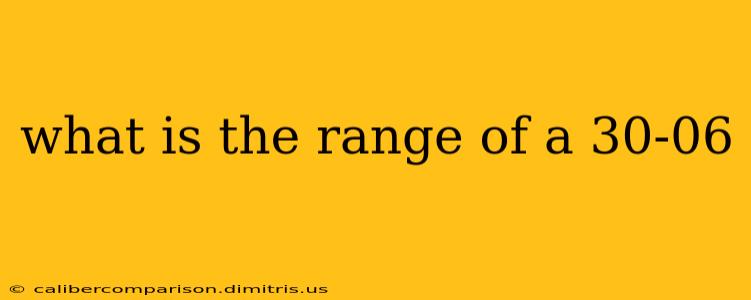The .30-06 Springfield, a legendary cartridge, boasts impressive range, but pinning down a single definitive answer is tricky. The effective range significantly differs based on several crucial factors. This article will delve into the nuances of .30-06 range, exploring the factors that influence it and providing a clearer understanding of its capabilities.
Factors Affecting .30-06 Range
Several key elements determine how far a .30-06 round can travel and remain effective:
1. Bullet Type:
- Bullet Weight: Heavier bullets generally have a flatter trajectory and longer range than lighter ones. A 180-grain bullet, for example, will travel further than a 150-grain bullet fired from the same rifle.
- Bullet Construction: The bullet's construction (full metal jacket, hollow point, soft point, etc.) impacts its ballistic coefficient. A bullet with a higher ballistic coefficient will experience less air resistance, extending its range.
- Bullet Shape: The bullet's shape and design influence its aerodynamic properties, affecting its trajectory and range. Certain designs, such as boat-tail bullets, are optimized for long-range accuracy.
2. Rifle Characteristics:
- Barrel Length: A longer barrel allows for more complete powder burn, resulting in higher muzzle velocity and extended range.
- Rifling Twist Rate: The rifling twist rate influences bullet stability, impacting accuracy and range. A properly matched twist rate is crucial for optimal performance at longer distances.
- Scope Quality: A high-quality scope with good optics and accurate adjustments is essential for accurate shooting at longer ranges. The scope's magnification also plays a role in target acquisition and precise shot placement.
3. Environmental Conditions:
- Wind: Wind is a major factor affecting bullet trajectory. Strong winds can significantly deflect bullets, reducing accuracy and effective range.
- Temperature: Temperature affects both powder burn rate and air density, influencing bullet velocity and trajectory.
- Altitude: Higher altitudes result in thinner air, which can slightly increase range due to reduced air resistance. However, this effect is typically less significant than other factors.
Maximum vs. Effective Range: A Crucial Distinction
It's vital to differentiate between maximum range and effective range:
-
Maximum Range: This refers to the farthest distance a bullet can travel before hitting the ground. This distance can be considerable for a .30-06, potentially exceeding 3 miles under ideal conditions, but accuracy at such ranges is almost non-existent.
-
Effective Range: This represents the distance at which a shooter can consistently achieve accurate hits on a target. For a .30-06, the effective range for hunting is generally considered to be around 600-800 yards with proper equipment, ammunition, and skill. Beyond this distance, factors like bullet drop, wind drift, and diminishing energy make accurate shot placement extremely challenging.
Conclusion: A Powerful, Versatile Cartridge
The .30-06 Springfield remains a popular and powerful cartridge, suitable for various applications, from hunting to long-range target shooting. While its maximum range might extend for miles, its effective range is a more practical measure, and this depends heavily on the factors outlined above. Understanding these factors enables responsible and accurate use of this classic cartridge. Always prioritize safety and practice responsible firearm handling.

